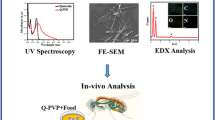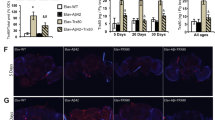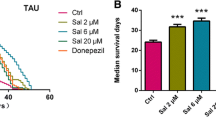Abstract
In the current study, the therapeutic potential of cerium oxide nanoparticles (nCeO2) was investigated in a human tau (htau) model of Alzheimer’s disease (AD), using Drosophila melanogaster as an in vivo model. nCeO2 synthesised via the hydroxide-mediated approach were characterised using Fourier transform infrared (FTIR), transmission electron microscopy (TEM), X-ray diffraction (XRD) analyses and Raman spectroscopy. Characterisation studies confirmed the formation of pure cubic-structured nCeO2 and showed that the particles were spherically shaped, with an average size between 20 and 25 nm. The synthesised nCeO2 were then administered as part of the diet to transgenic Drosophila for one month, at 0.1 and 1 mM concentrations, and its effect on the biochemical levels of superoxide dismutase (SOD), acetylcholinesterase (AChE), and the climbing activity of flies were studied in a pan-neuronal model (elav; htau) of AD. Using an eye-specific model of htau expression (GMR; htau), the effect of nCeO2 on htau and autophagy-related (ATG) gene expression was also studied. Dietary administration of nCeO2 at a concentration of 1 mM restored the activity of SOD similar to that of control, but both concentrations of nCeO2 failed to modulate the level of AChE, and did not elicit any significant improvements in the climbing activity of elav; htau flies. Moreover, nCeO2 at a concentration of 1 mM significantly affected the climbing activity of elav; htau flies. nCeO2 also elicited a significant decrease in htau gene expression at both concentrations and increased the mRNA expression of key autophagy genes ATG1 and ATG18. The results therefore indicate that nCeO2 aids in replenishing the levels of SOD and tau clearance via the activation of autophagy.





Similar content being viewed by others
References
Adebayo OA, Akinloye O, Adaramoye OA (2018) Cerium oxide nanoparticle elicits oxidative stress, endocrine imbalance and lowers sperm characteristics in testes of balb/c mice. Andrologia. https://doi.org/10.1111/and.12920
Alamro AA, Alsulami EA, Almutlaq M, Alghamedi A, Alokail M, Haq SH (2020) Therapeutic potential of vitamin d and curcumin in an in vitro model of alzheimer disease. J Cent Nerv Syst Dis 12:1179573520924311. https://doi.org/10.1177/1179573520924311
Alaraby M, Annangi B, Hernández A, Creus A, Marcos R (2015a) A comprehensive study of the harmful effects of ZnO nanoparticles using Drosophila melanogaster as an in vivo model. J Hazard Mater 296:166–174. https://doi.org/10.1016/j.jhazmat.2015.04.053
Alaraby M et al (2015b) Antioxidant and antigenotoxic properties of CeO2 NPs and cerium sulphate: Studies with Drosophila melanogaster as a promising in vivo model. Nanotoxicology 9:749–759. https://doi.org/10.3109/17435390.2014.976284
Ali D, Alarifi S, Alkahtani S, AlKahtane AA, Almalik A (2015) Cerium oxide nanoparticles induce oxidative stress and genotoxicity in human skin melanoma cells. Cell Biochem Biophys 71:1643–1651. https://doi.org/10.1007/s12013-014-0386-6
Ando K, Oka M, Ohtake Y, Hayashishita M, Shimizu S, Hisanaga S, Iijima KM (2016) Tau phosphorylation at Alzheimer’s disease-related Ser356 contributes to tau stabilization when PAR-1/MARK activity is elevated. Biochem Biophys Res Commun 478:929–934. https://doi.org/10.1016/j.bbrc.2016.08.053
Azari A, Shokrzadeh M, Zamani E, Amani N, Shaki F (2019) Cerium oxide nanoparticles protects against acrylamide induced toxicity in HepG2 cells through modulation of oxidative stress. Drug Chem Toxicol 42:54–59. https://doi.org/10.1080/01480545.2018.1477793
Bakota L, Brandt R (2016) Tau biology and tau-directed therapies for Alzheimer’s disease. Drugs 76:301–313. https://doi.org/10.1007/s40265-015-0529-0
Baldim V, Bedioui F, Mignet N, Margaill I, Berret JF (2018) The enzyme-like catalytic activity of cerium oxide nanoparticles and its dependency on Ce3+ surface area concentration. Nanoscale 10:6971–6980. https://doi.org/10.1039/C8NR00325D
Braak H, Braak E (1991) Demonstration of amyloid deposits and neurofibrillary changes in whole brain sections. Brain Pathol 1:213–216. https://doi.org/10.1111/j.1750-3639.1991.tb00661.x
Brand AH, Perrimon N (1993) Targeted gene expression as a means of altering cell fates and generating dominant phenotypes. Development 118:401–415
Casado A, Encarnación López-Fernández M, Concepción Casado M, de La Torre R (2008) Lipid peroxidation and antioxidant enzyme activities in vascular and Alzheimer dementias. Neurochem Res 33:450–458. https://doi.org/10.1007/s11064-007-9453-3
Cimini A et al (2012) Antibody-conjugated PEGylated cerium oxide nanoparticles for specific targeting of Aβ aggregates modulate neuronal survival pathways. Acta Biomater 8:2056–2067. https://doi.org/10.1016/j.actbio.2012.01.035
Dan P et al (2019) Evaluation of hydroxyapatite nanoparticles - induced in vivo toxicity in Drosophila melanogaster. Appl Surf Sci 484:568–577. https://doi.org/10.1016/j.apsusc.2019.04.120
Davies CW, Stjepanovic G, Hurley JH (2015) How the Atg1 complex assembles to initiate autophagy. Autophagy 11:185–186. https://doi.org/10.4161/15548627.2014.984281
Di Meco A, Curtis ME, Lauretti E, Praticò D (2020) Autophagy dysfunction in Alzheimer’s disease: mechanistic insights and new therapeutic opportunities. Biol Psychiatry 87:797–807. https://doi.org/10.1016/j.biopsych.2019.05.008
Domínguez-Martín E, Cardenal-Muñoz E, King JS, Soldati T, Coria R, Escalante R (2017) Methods to monitor and quantify autophagy in the social amoeba dictyostelium discoideum. Cells 6:18. https://doi.org/10.3390/cells6030018
Dowding JM, Dosani T, Kumar A, Seal S, Self WT (2012) Cerium oxide nanoparticles scavenge nitric oxide radical (˙NO). Chem Commun (Camb) 48:4896–4898. https://doi.org/10.1039/c2cc30485f
Dowding JM et al (2014) Cerium oxide nanoparticles protect against Aβ-induced mitochondrial fragmentation and neuronal cell death. Cell Death Differ 21:1622–1632. https://doi.org/10.1038/cdd.2014.72
Eriksson P et al (2018) Cerium oxide nanoparticles with antioxidant capabilities and gadolinium integration for MRI contrast enhancement. Sci Rep 8:6999. https://doi.org/10.1038/s41598-018-25390-z
Fahmy AM, Labonté P (2017) The autophagy elongation complex (ATG5-12/16L1) positively regulates HCV replication and is required for wild-type membranous web formation. Sci Rep 7:40351. https://doi.org/10.1038/srep40351
Fukai T, Ushio-Fukai M (2011) Superoxide dismutases: role in redox signaling, vascular function, and diseases. Antioxid Redox Sign 15:1583–1606. https://doi.org/10.1089/ars.2011.3999
Gistelinck M, Lambert JC, Callaerts P, Dermaut B, Dourlen P (2012) Drosophila models of tauopathies: what have we learned? Int J Alzheimers Dis 2012:970980. https://doi.org/10.1155/2012/970980
Goldsmith J, Levine B, Debnath J (2014) Chapter two—Autophagy and cancer metabolism. In: Galluzzi L, Kroemer G (eds) Methods in enzymology, vol 542. Academic Press, Cambridge, pp 25–57. https://doi.org/10.1016/B978-0-12-416618-9.00002-9
Hardy J, Allsop D (1991) Amyloid deposition as the central event in the aetiology of Alzheimer’s disease. Trends Pharmacol Sci 12:383–388. https://doi.org/10.1016/0165-6147(91)90609-V
Hardy J, Selkoe DJ (2002) The amyloid hypothesis of Alzheimer’s disease: progress and problems on the road to therapeutics. Science (New York, NY) 297:353. https://doi.org/10.1126/science.1072994
Hardy JA, Higgins GA (1992) Alzheimer’s disease: the amyloid cascade hypothesis. Science (New York, NY) 256:184–185. https://doi.org/10.1126/science.1566067
Ihara Y et al (1997) Free radicals and superoxide dismutase in blood of patients with Alzheimer’s disease and vascular dementia. J Neurol Sci 153:76–81. https://doi.org/10.1016/S0022-510X(97)00172-X
Jameson L, Frey T, Zeeberg B, Dalldorf F, Caplow M (1980) Inhibition of microtubule assembly by phosphorylation of microtubule-associated proteins. Biochemistry 19:2472–2479. https://doi.org/10.1021/bi00552a027
Kandimalla R, Reddy PH (2017) Therapeutics of neurotransmitters in Alzheimer’s disease. J Alzheimers Dis 57:1049–1069. https://doi.org/10.3233/JAD-161118
Korsvik C, Patil S, Seal S, Self WT (2007) Superoxide dismutase mimetic properties exhibited by vacancy engineered ceria nanoparticles. Chem Commun (Camb). https://doi.org/10.1039/b615134e
Krüger U, Wang Y, Kumar S, Mandelkow E-M (2012) Autophagic degradation of tau in primary neurons and its enhancement by trehalose. Neurobiol Aging 33:2291–2305. https://doi.org/10.1016/j.neurobiolaging.2011.11.009
Kwon HJ et al (2016) Mitochondria-Targeting Ceria Nanoparticles as Antioxidants for Alzheimer’s Disease. ACS Nano 10:2860–2870. https://doi.org/10.1021/acsnano.5b08045
Li Q, Liu Y, Sun M (2017) Autophagy and Alzheimer’s disease. Cell Mol Neurobiol 37:377–388. https://doi.org/10.1007/s10571-016-0386-8
Lindwall G, Cole RD (1984) Phosphorylation affects the ability of tau protein to promote microtubule assembly. J Biol Chem 259:5301–5305
Marcus DL, Thomas C, Rodriguez C, Simberkoff K, Tsai JS, Strafaci JA, Freedman ML (1998) Increased peroxidation and reduced antioxidant enzyme activity in Alzheimer’s disease. Exp Neurol 150:40–44. https://doi.org/10.1006/exnr.1997.6750
Mehta M, Adem A, Sabbagh M (2012) New acetylcholinesterase inhibitors for Alzheimer’s disease. Int J Alzheimers Dis 2012:728983–728983. https://doi.org/10.1155/2012/728983
Mershin A, Pavlopoulos E, Fitch O, Braden BC, Nanopoulos DV, Skoulakis EM (2004) Learning and memory deficits upon TAU accumulation in Drosophila mushroom body neurons. Learn Mem 11:277–287. https://doi.org/10.1101/lm.70804
Mishra M, Sabat D, Ekka B, Sahu S, P U, Dash P, (2017) Oral intake of zirconia nanoparticle alters neuronal development and behaviour of Drosophila melanogaster. J Nanopart Res 19:282. https://doi.org/10.1007/s11051-017-3971-y
Nemmar A, Yuvaraju P, Beegam S, Fahim MA, Ali BH (2017) Cerium oxide nanoparticles in lung acutely induce oxidative stress, inflammation, and DNA damage in various organs of mice. Oxid Med Cell Longev 2017:9639035. https://doi.org/10.1155/2017/9639035
Ong C, Yung L-YL, Cai Y, Bay B-H, Baeg G-H (2015) Drosophila melanogaster as a model organism to study nanotoxicity. Nanotoxicology 9:396–403. https://doi.org/10.3109/17435390.2014.940405
Pierre M, Nunez J (1983) Multisite phosphorylation of tau proteins from rat brain. Biochem Biophys Res Commun 115:212–219. https://doi.org/10.1016/0006-291x(83)90991-9
Pirmohamed T et al (2010) Nanoceria exhibit redox state-dependent catalase mimetic activity. Chem Commun (Camb) 46:2736–2738. https://doi.org/10.1039/b922024k
Querfurth HW, LaFerla FM (2010) Alzheimer’s disease. N Engl J Med 362:329–344. https://doi.org/10.1056/NEJMra0909142
Saify ZS, Sultana N (2014) Chapter 7—Role of acetylcholinesterase inhibitors and Alzheimer disease. In: Attaur R, Choudhary MI (eds) Drug design and discovery in Alzheimer’s disease. Elsevier, Amsterdam, pp 387–425. https://doi.org/10.1016/B978-0-12-803959-5.50007-6
Schwotzer D, Ernst H, Schaudien D, Kock H, Pohlmann G, Dasenbrock C, Creutzenberg O (2017) Effects from a 90-day inhalation toxicity study with cerium oxide and barium sulfate nanoparticles in rats. Part Fibre Toxicol 14:23. https://doi.org/10.1186/s12989-017-0204-6
Sheik Mohideen S, Yamasaki Y, Omata Y, Tsuda L, Yoshiike Y (2015) Nontoxic singlet oxygen generator as a therapeutic candidate for treating tauopathies. Sci Rep 5:10821. https://doi.org/10.1038/srep10821
Shpilka T, Mizushima N, Elazar Z (2012) Ubiquitin-like proteins and autophagy at a glance. J Cell Sci 125:2343. https://doi.org/10.1242/jcs.093757
Sundararajan V, Dan P, Kumar A, Venkatasubbu GD, Ichihara S, Ichihara G, Sheik Mohideen S (2019) Drosophila melanogaster as an in vivo model to study the potential toxicity of cerium oxide nanoparticles. Appl Surf Sci 490:70–80. https://doi.org/10.1016/j.apsusc.2019.06.017
Szymanski CJ et al (2015) Shifts in oxidation states of cerium oxide nanoparticles detected inside intact hydrated cells and organelles. Biomaterials 62:147–154. https://doi.org/10.1016/j.biomaterials.2015.05.042
Takahashi Y, Hirose F, Matsukage A, Yamaguchi M (1999) Identification of three conserved regions in the DREF transcription factors from Drosophila melanogaster and Drosophila virilis. Nucleic Acids Res 27:510–516. https://doi.org/10.1093/nar/27.2.510
Tisi A, Passacantando M, Lozzi L, Riccitelli S, Bisti S, Maccarone R (2019) Retinal long term neuroprotection by Cerium Oxide nanoparticles after an acute damage induced by high intensity light exposure. Exp Eye Res 182:30–38. https://doi.org/10.1016/j.exer.2019.03.003
Vafaei-Pour Z, Shokrzadeh M, Jahani M, Shaki F (2018) Embryo-protective effects of cerium oxide nanoparticles against gestational diabetes in mice. Iran J Pharm Res 17:964–975
Wang Y, Krüger U, Mandelkow EM (2010) Generation of tau aggregates and clearance by autophagy in an inducible cell model of tauopathy. Neurodegener Dis 7:103–107. https://doi.org/10.1159/000285516
Wangler MF, Yamamoto S, Bellen HJ (2015) Fruit flies in biomedical research. Genetics 199:639–653. https://doi.org/10.1534/genetics.114.171785
Weingarten MD, Lockwood AH, Hwo SY, Kirschner MW (1975) A protein factor essential for microtubule assembly. Proc Natl Acad Sci USA 72:1858–1862. https://doi.org/10.1073/pnas.72.5.1858
Weller J, Budson A (2018) Current understanding of Alzheimer's disease diagnosis and treatment. F1000Res 7:F1000 Faculty Rev-1161. doi: https://doi.org/10.12688/f1000research.14506.1
Wittmann CW, Wszolek MF, Shulman JM, Salvaterra PM, Lewis J, Hutton M, Feany MB (2001) Tauopathy in Drosophila: neurodegeneration without neurofibrillary tangles. Science (New York, NY) 293:711–714. https://doi.org/10.1126/science.1062382
Yamamoto H, Ohsumi Y (2014) Chapter 4—The molecular mechanisms underlying autophagosome formation in yeast. In: Hayat MA (ed) Autophagy: cancer, other pathologies, inflammation, immunity, infection, and aging. Academic Press, Amsterdam, pp 67–77. https://doi.org/10.1016/B978-0-12-405529-2.00004-4
Zhang Z-H et al (2017) Selenomethionine mitigates cognitive decline by targeting both tau hyperphosphorylation and autophagic clearance in an alzheimer’s disease mouse model. J Neurosci 37:2449–2462. https://doi.org/10.1523/jneurosci.3229-16.2017
Zhao Y, Xu Q, Xu W, Wang D, Tan J, Zhu C, Tan X (2016) Probing the molecular mechanism of cerium oxide nanoparticles in protecting against the neuronal cytotoxicity of Aβ1-42 with copper ions. Metallomics 8:644–647. https://doi.org/10.1039/c5mt00242g
Zhou L et al (2017) Tau association with synaptic vesicles causes presynaptic dysfunction. Nat Commun 8:15295. https://doi.org/10.1038/ncomms15295
Acknowledgements
Dr Sahabudeen acknowledges the Department of Science and Technology (DST) −Science and Engineering Research Board (FILE NO. ECR/2016/000490) for providing financial assistance. The authors acknowledge HRTEM, XRD and Raman facilities at SRM Institute of Science and Technology set up with support from MNRE (Project No. 31/03/2014-15/PVSE-R&D), Government of India. The authors acknowledge the SRM-DBT Platform for Advanced Life Sciences for providing the facility for performing Real-Time PCR experiments. The authors also thank Mr. V.P. Narayanan Nampoothiri for technical assistance.
Author information
Authors and Affiliations
Corresponding author
Ethics declarations
Conflict of interest
The authors declare that there is no conflict of interest in the publication.
Rights and permissions
About this article
Cite this article
Sundararajan, V., Venkatasubbu, G.D. & Sheik Mohideen, S. Investigation of therapeutic potential of cerium oxide nanoparticles in Alzheimer’s disease using transgenic Drosophila. 3 Biotech 11, 159 (2021). https://doi.org/10.1007/s13205-021-02706-x
Received:
Accepted:
Published:
DOI: https://doi.org/10.1007/s13205-021-02706-x




